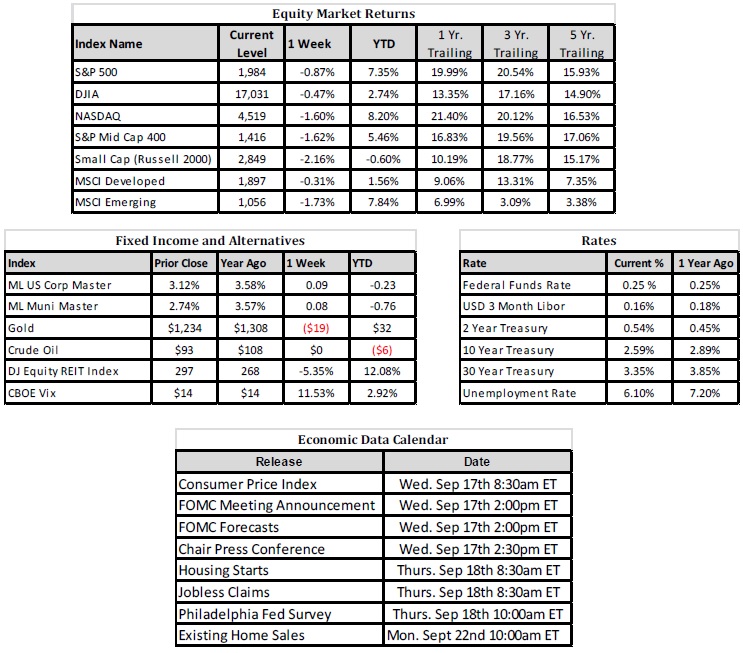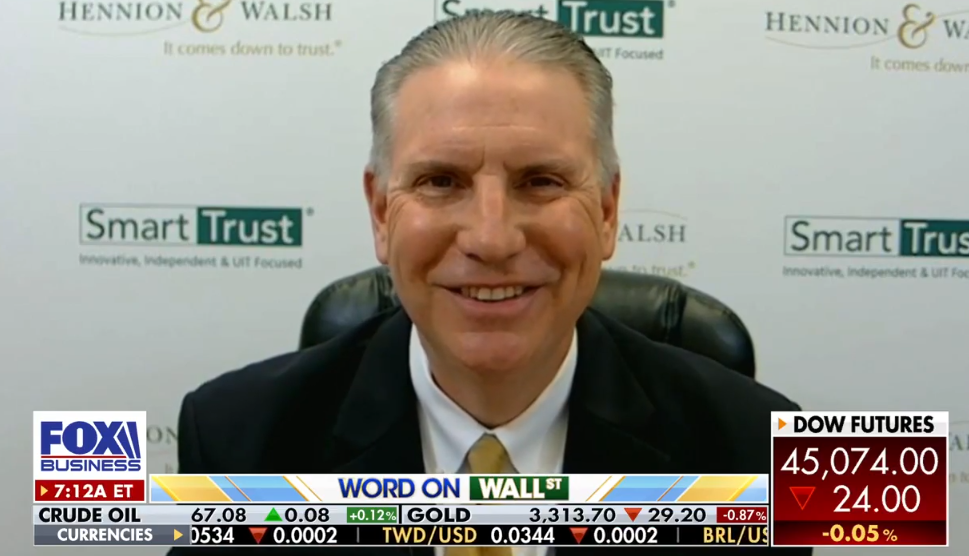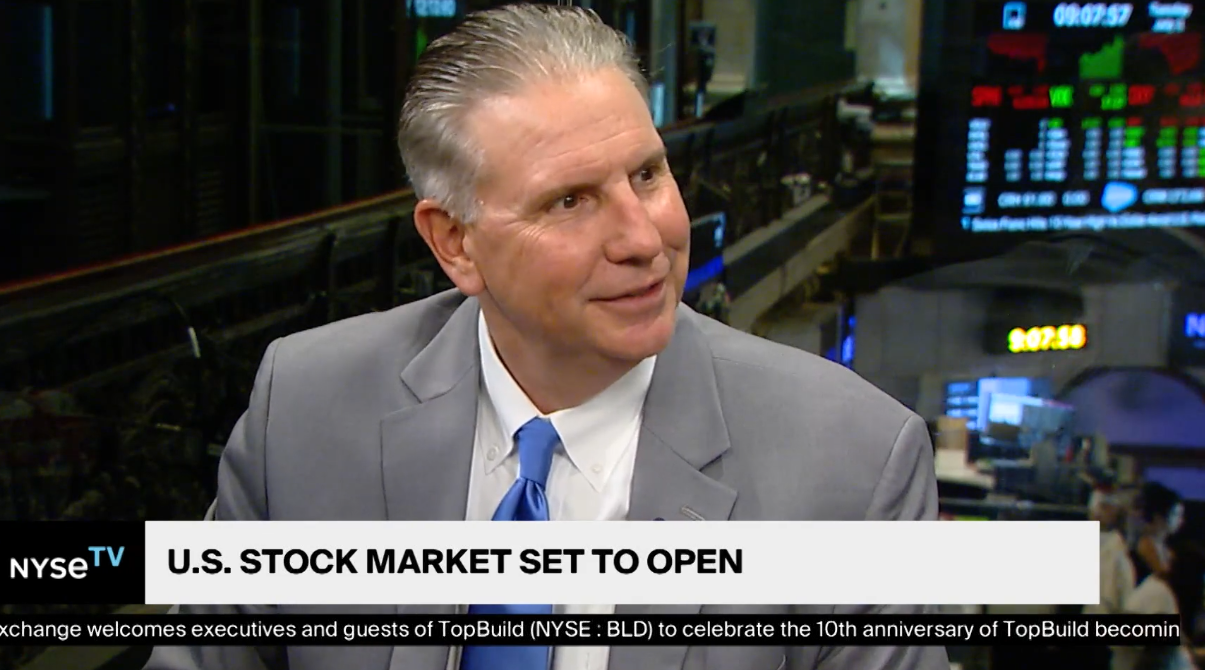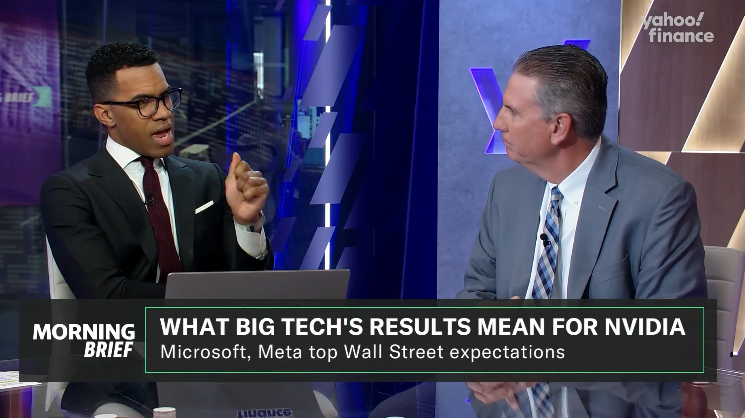
Capital Markets Update – Week of 9/15/2014
Market Overview
Sources: Rates Data and Economic Calendar—Bloomberg Markets as of 9/15/14; Equity Market Returns and Fixed Income and Alternatives Data—Wells Fargo Advisers as of 9/15/14.
Happening Now
Alibaba and the Fed Snatch Headlines
If you’ve read any financial articles this week there is a good chance that the topic centered on one of two events: the highly anticipated Alibaba IPO or the Federal Reserve’s upcoming FOMC meeting. Despite the amount of interest Alibaba has garnered recently as it readies itself for its debut on the NYSE on Friday under the ticker symbol BABA, we remain focused on the economic data leading into Tuesday and Wednesday’s FOMC meetings in addition to Wednesday’s Fed policy statement.
While many economists and some Regional Fed Bank Presidents believe that the U.S. economy is ready for higher rates, Yellen has warned that low wage growth and slack in the labor market allow for an environment of continued accommodation. So, despite the importance of the actual timing of the first interest rate hike, perhaps more important is the path the Fed takes and the level to which they are willing to increase interest rates. A recent Bloomberg survey found that while there is a wide consensus that rates will ultimately begin to rise in 2015, 57% of economists expect the median estimate for the federal funds rate at the end of 2015 to remain near 1.13 percent, indicating a slow and steady rise in rates.
This should be put in context of the Fed’s current target federal funds rate projection of 2.25% by the end of 2016. Janet Yellen made it clear after the March FOMC meeting that the future path of interest rates is data dependent after abandoning the two pronged approach of focusing on the unemployment rate and inflation expectations. Although the Fed has broadened their focus to include information beyond the unemployment rate and inflation expectations, these two measures remain important factors in measuring the health the U.S. economy and its ability to tolerate higher rates. Currently, the unemployment rate stands at 6.1% (below the 6.5% target Bernanke initial set in 2012 for considering raising rates) while the PCE Index, the Fed’s preferred inflation measure, increased at an annual rate of 1.6% in July from a year ago, below the committee’s 2.0% goal (full release here).
We have contended that the first rate hike will likely come approximately six months after the end of the tapering process, which, we expect to occur in October. This would allow for the first increase in rates to occur during the April FOMC meeting. The effect of rising interest rates has been the focus of both equity and fixed income investors for some time now due to the ripple effect the rates will have across financial models and asset pricing. While the week’s hottest topic may be whether or not Alibaba will be the largest IPO in history (overtaking The Agricultural Bank of China’s 2010 IPO when $22.1B was raised), insight into the future of U.S. monetary policy and the associated longer term market implications will come out of the Fed’s policy statement on Wednesday.
Important Information and Disclaimers
Past Performance is not a guide to future performance.
Investing in foreign securities presents certain risks not associated with domestic investments, such as currency fluctuation, political and economic instability, and different accounting standards. This may result in greater share price volatility. These risks are heightened in emerging markets.
There are special risks associated with an investment in real estate, including credit risk, interest rate fluctuations and the impact of varied economic conditions. Distributions from REIT investments are taxed at the owner’s tax bracket.
The prices of small company and mid cap stocks are generally more volatile than large company stocks. They often involve higher risks because smaller companies may lack the management expertise, financial resources, product diversification and competitive strengths to endure adverse economic conditions.
Investing in commodities is not suitable for all investors. Exposure to the commodities markets may subject an investment to greater share price volatility than an investment in traditional equity or debt securities. Investments in commodities may be affected by changes in overall market movements, commodity index volatility, changes in interest rates or factors affecting a particular industry or commodity.
Products that invest in commodities may employ more complex strategies which may expose investors to additional risks.
Investing in fixed income securities involves certain risks such as market risk if sold prior to maturity and credit risk especially if investing in high yield bonds, which have lower ratings and are subject to greater volatility. All fixed income investments may be worth less than original cost upon redemption or maturity. Bond Prices fluctuate inversely to changes in interest rates. Therefore, a general rise in interest rates can result in the decline of the value of your investment.
Definitions
MSCI- EAFE: The Morgan Stanley Capital International Europe, Australasia and Far East Index, a free float-adjusted market capitalization index that is designed to measure developed-market equity performance, excluding the United States and Canada.
MSCI-Emerging Markets: The Morgan Stanley Capital International Emerging Market Index, is a free float-adjusted market capitalization index that is designed to measure the performance of global emerging markets of about 25 emerging economies.
Russell 3000: The Russell 3000 measures the performance of the 3000 largest US companies based on total market capitalization and represents about 98% of the investible US Equity market.
ML BOFA US Corp Mstr [Merill Lynch US Corporate Master]: The Merrill Lynch Corporate Master Market Index is a statistical composite tracking the performance of the entire US corporate bond market over time.
ML Muni Master [Merill Lynch US Corporate Master]: The Merrill Lynch Municipal Bond Master Index is a broad measure of the municipal fixed income market.
Investors cannot directly purchase any index.
LIBOR, London Interbank Offered Rate, is the rate of interest at which banks offer to lend money to one another in the wholesale money markets in London.
The Dow Jones Industrial Average is an unweighted index of 30 “blue-chip” industrial U.S. stocks.
The S&P Midcap 400 Index is a capitalization-weighted index measuring the performance of the mid-range sector of the U.S. stock market, and represents approximately 7% of the total market value of U.S. equities. Companies in the Index fall between S&P 500 Index and the S&P SmallCap 600 Index in size: between $1-4 billion.
DJ Equity REIT Index represents all publicly traded real estate investment trusts in the Dow Jones U.S. stock universe classified as Equity REITs according to the S&P Dow Jones Indices REIT Industry Classification Hierarchy. These companies are REITSs that primarily own and operate income-producing real estate.




